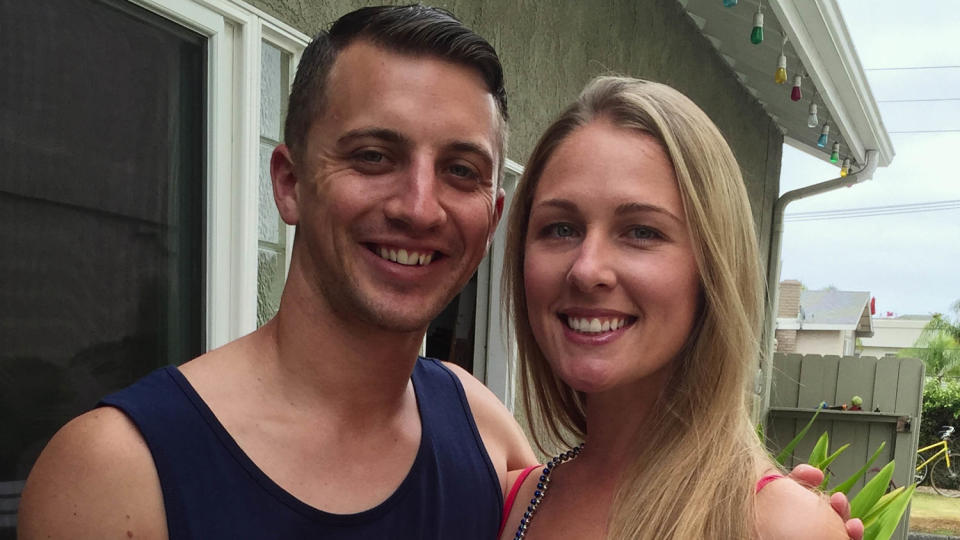'American Nightmare' couple still have questions about the kidnapping. Here are a few
Within hours of premiering on Netflix, “American Nightmare” shot to the top of the streaming giant’s most-watched charts.
The three-episode true-crime series documented the kidnapping of Denise Huskins in 2015, and how authorities initially suspected her then-boyfriend, now-husband Aaron Quinn of the abduction.
But when she reappeared near her childhood home two days later, the series recounted how investigators then turned on her — and accused her, without evidence, of faking her own disappearance.

Huskins’ kidnapper, Matthew Muller, pleaded guilty to one count of kidnapping in September 2016 in Huskins and Quinn’s case, according to the U.S. Attorney’s Office. He is serving a 40-year sentence at the Federal Correctional Institution in Tucson, Arizona, according to the Bureau of Prisons.
In 2022, Muller pleaded no contest to two counts of forcible rape in California in Huskins’ case, according to the district attorney’s office. He also pleaded guilty to state charges of robbery of an inhabited dwelling, residential burglary and false imprisonment.
Huskins and Quinn, now married with two children, tell TODAY.com on Jan. 25 the reactions — and support — just one week after the release of “American Nightmare” has been validating.
“It’s certainly been overwhelming in the best possible way. It’s nice to see the main themes that we wanted people to take away from the series, that they are connecting to that,” Huskins says. “In all honesty, it’s still difficult to be in a position to be exposed and vulnerable again, although it’s all positive, I think our bodies still process the trauma from before. There’s some old wounds opened, but thankfully we have each other and our girls to give us a moment of joy.”
Huskins and Quinn, along with Nicole Weisensee Egan, co-authored “Victim F: From Crime Victims to Suspects to Survivors” in 2021, which tells their story, as recounted in “American Nightmare,” but also goes in-depth into topics the series couldn’t investigate.

“We take people with us, through our experience, from the beginning. I think it can give people a better perspective on how things unfolded and certain details that the series just didn’t have the time for, but also the format — it’s still true crime. There’s still that aspect of the twists and the turns and the whodunnit thing,” Huskins explains of the documentary.
“With that, it gets people to watch and it’s really captivating and shocking, but there’s certain details that you can’t quite go back to for the sake of storytelling. So that does leave questions.”
Huskins and Quinn tell TODAY.com about the common questions viewers are left with after watching “American Nightmare” — plus questions they still have themselves.
Did they have any expectations for the Netflix series?
Quinn says he expected the show to be popular on Netflix, but that he was surprised by people’s reactions to the series.
“I didn’t fully expect how emotionally it connected to people, which is what we were hoping for because you need to change hearts before you change minds,” he says. “When we had a preview of the series a few months back, I was like, ‘This will be a hit.’ I did not expect it to break records, though. Still, expecting one thing and actually having it happen is a completely different experience.”
Huskins added, “I think it’s a testament to the times we are in and the turning point we are taking collectively as a society and as an audience consuming these real-life stories,” she says.
“Things are shifting to empowering victims, believing victims, and wanting to know the truth, not just the narrative that’s dictated to us by people in a position of power. There’s a great power in awareness, and people are passionate for things to change.”
Do they think Muller acted alone?
No one besides Muller has been charged in Huskins and Quinn’s case, but the pair believe two other people were involved in their home break-in and the abduction of Huskins.
“We know that (the authorities) decided that he acted alone from the get-go,” Quinn says. “It’s because he went to Harvard that people think he fooled us. And that’s the only reason. I don’t think Harvard has any classes to teach you how to do this.”
Quinn says after reviewing the police report, Vallejo Police investigators wrote there were two cars leaving his residence around five o’clock, close together, after the break-in.
“I had a white Camry, Denise was taken in a white Mustang — it’s impossible for Muller to drive both cars at once,” Quinn says.
“There was also a white male seen outside my house at five o’clock in the morning after they left, when Muller had Denise in the car,” he adds, citing the police report. “None of those things were followed up on. So unfortunately, the police are going to let dangerous criminals get away with it, just like they did before. Because they’ve always, always taken the easiest route.”
What details do they know about Agent Sesma’s relationship with Andrea?
As shown in the series, Muller told Quinn and Huskins that Andrea Roberts, Quinn’s ex-girlfriend, was the initial target of the kidnapping. According to an arrest warrant for Muller obtained by NBC Bay Area, emails sent to the San Francisco Chronicle by Huskins' alleged kidnappers also wrote Roberts was the intended target of the abduction.
Quinn tells TODAY.com Roberts told him she had an "intimate relationship" with FBI Agent David Sesma, who was investigating Huskins’ kidnapping, before he and Roberts began dating.
To Quinn, this was a conflict of interest, one he reported to the FBI through his attorneys.
“(Sesma) should have recused himself from the case. And we know that he was aware of the conflict of interest because he never questioned me or questioned my ex,” Quinn says. “Instead, he only spoke with (Huskins) and then accused her of lying to the FBI without an ounce of evidence.”
The couple’s defense attorney Doug Rappaport explains in the documentary: “There’s absolutely no way Sesma should be on this case. It’s a clear, unequivocal, black and white conflict of interest. So I write to the office of Inspector General, explain the situation. Their response: ‘The appropriate authorities found this conduct “unproblematic.”’”
Sesma is still an agent with the bureau, Huskins says.
The Sacramento FBI field office said in a statement to TODAY.com all bureau investigations are “conducted in a manner that is respectful to victims’ right to privacy and court records detail the efforts of the personnel who investigate our cases.”
“This investigation involved a number of FBI personnel who were committed to uncovering the truth by leveraging many techniques and exploring all possibilities of this case. And despite what has been publicly alleged by some, the FBI determined that no conflict of interest existed,” the FBI Sacramento Field Office said. “Ultimately, the investigation resulted in the successful conviction of Matthew Muller for federal kidnapping and a sentence of 40 years for the crime and a separate conviction and sentence for state charges.”
Huskins says they have not gotten any answers about why Roberts was the intended target of the abduction, from Muller or from authorities.
Have they heard from the Vallejo Police Department?
Huskins and Quinn say they have not directly heard from Vallejo Police since the release of the series.
“They were invited to participate (in the series). They said no. In our book, we asked for comment. They said no,” Quinn says. “They have only apologized through the media, so that the media will say they apologize, but they have never spoken to us directly.”
In 2018, the city of Vallejo agreed to pay $2.5 million to settle a defamation lawsuit Huskins and Quinn filed after the Vallejo Police Department accused the couple of faking Huskins’ kidnapping, the Los Angeles Times reported, citing a statement from the couple’s attorney.
The Vallejo Police Department did not respond to a request for comment from TODAY.com.
Do they still keep in touch with Misty?
Huskins says she and Quinn have stayed in touch with Sgt. Misty Carausu of the Dublin Police Services of the Alameda County Sheriff’s Department, who found evidence linking Muller to Huskins’ abduction while investigating a separate home invasion in Dublin, California.
“We’ve stayed connected over the years. We were able to see her the weekend before the series came out,” Huskins says. “We both have two daughters close in age and we had always wanted to have them meet, and so they got to meet and play and it’s just really nice to see her and her husband in person again.”
“Certainly throughout this last week with everything, we’ve been just back and forth texting. She’s just a really special person and a special person in law enforcement,” she continues. “To really hear all that she went through around this case — she had gone through her own struggles, and I’m glad that she’s getting recognized for the work that she did.”
Quinn and Huskins’ case remained unsolved for months following the break-in and abduction until the Dublin Police Services arrested Muller on charges from a separate home invasion case on June 8, 2015, according to the U.S. Attorney’s Office.
In the Dublin home invasion, a couple had been tied up while Muller attempted to abduct their daughter, where investigators found a cellphone they later traced to Muller, according to authorities.
Dublin police searched Muller‘s South Lake Tahoe cabin, and located evidence related to Huskins’ abduction, according to the U.S. Attorney’s Office.
“That’s one of the most frustrating and disappointing parts of it — is we never got a proper investigation,” Huskins says of her experience. “And thank God Misty investigated her case properly. But then she also had restraints. As soon as she called the FBI, they took all the evidence and she couldn’t look into it more. I wish she could have.”
What have they told their children about the series and the incident?
Huskins and Quinn have two daughters, ages 4 and 1. Huskins says they plan to discuss what happened to them with their children when they’re older.
Quinn adds: “When it’s age appropriate, we’ll speak about it, as it’s a major part of our lives and we don’t want to hide that from them because we want to know that if anything happens to them, they can come to us. So we need to be honest with them as well. Obviously, it just needs to be appropriate to their age.”
“The truth is, they are our happy ending, so I want them to know that,” he adds.
This article was originally published on TODAY.com

